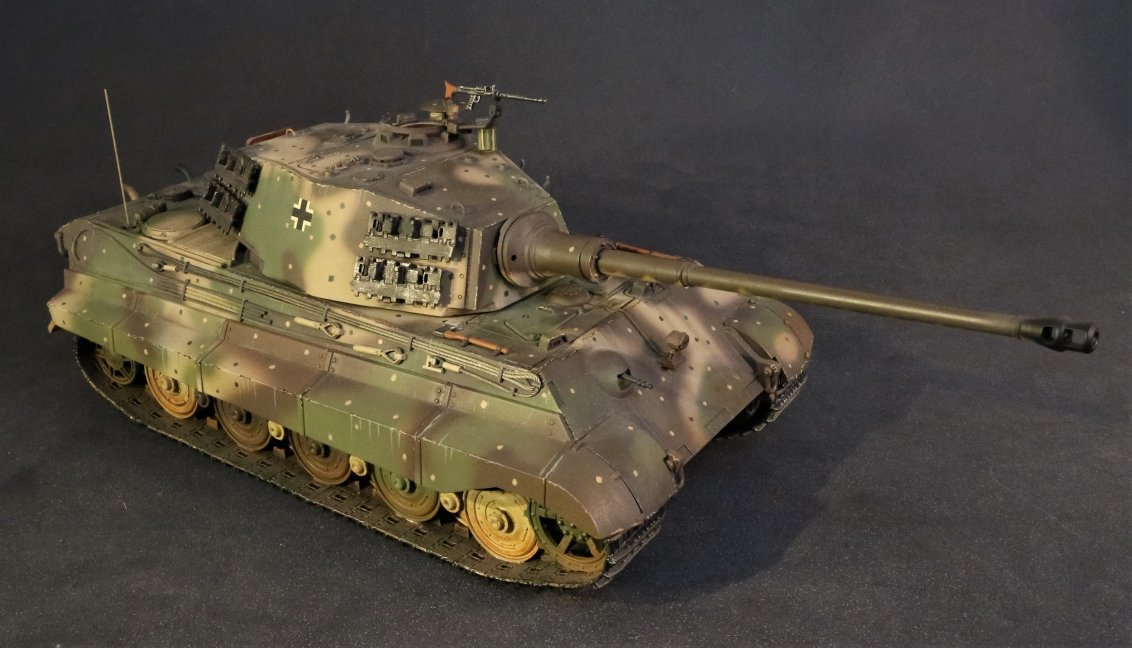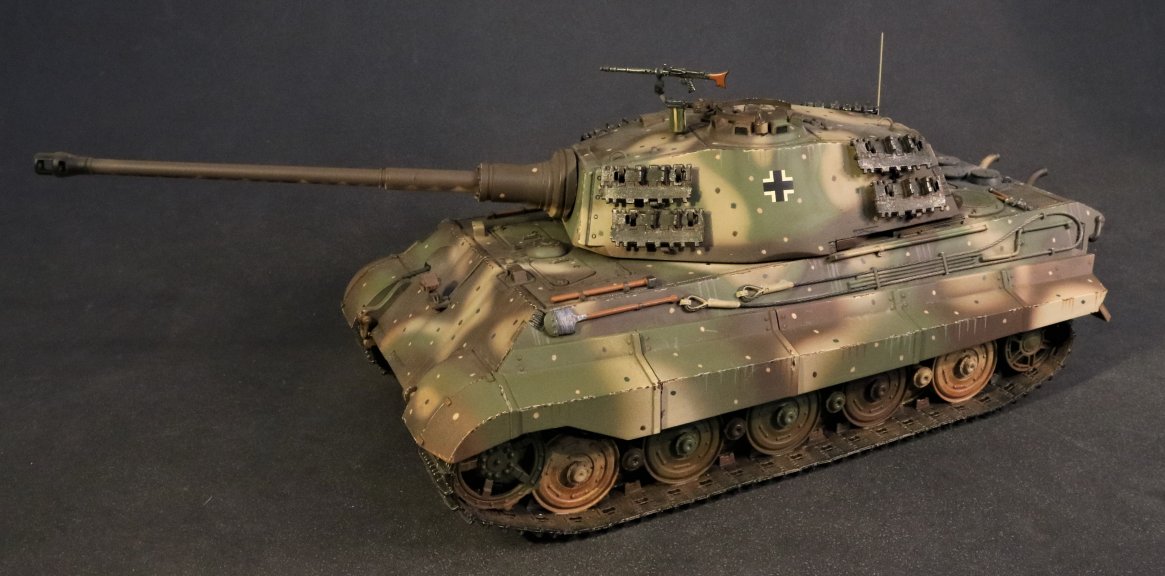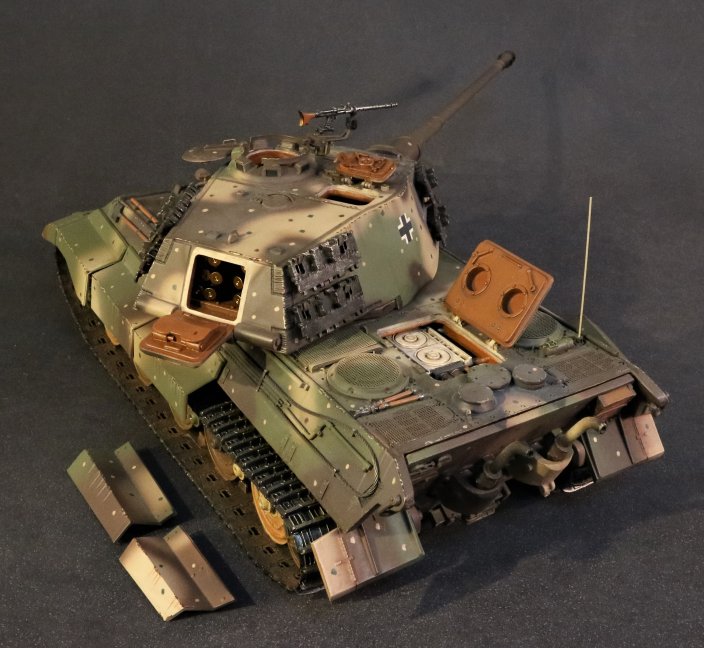- Joined
- Feb 2, 2011
- Messages
- 2,292
NEW RELEASES FOR MAY 2021
THE SECOND WORLD WAR
GERMAN ARMOUR
The Panzerkampfwagen VI Ausf B. Tiger II, commonly referred to as the King Tiger, was the successor to the legendary Tiger I heavy tank. It was designed to be even more heavily armed and armored than its iconic predecessor. Like the Panther tank, it incorporated design improvements gleaned from combat experience on the Eastern Front. The King Tiger was armed with the finest tank gun of WW2, the dreaded long barreled 8.8 cm KwK. L/71. Coupled with excellent sighting optics, this cannon was capable of destroying any Allied tank with ease, while it's well sloped armor provided excellent protection. In fact, German armaments officials during the war stated the King Tiger's front profile was impervious to all Allied weapons and there is no evidence that the King Tiger's 150mm thick glacis plate was ever penetrated in combat. To defeat the King Tiger, Allied tanks would have to outflank it in order to take shots at its weaker side and rear armor. In the hands of a skilled crew, the King Tiger was a fearsome opponent.
This massive armament and extremely thick armor came at the price of weight, and at almost 70 tons the King Tiger was the heaviest production tank of World War Two. Due to engine technology limitations of the time, the King Tiger was underpowered, since it used the same 750 horsepower Maybach HL 230 engine found on the much lighter Tiger I and Panther tanks. Additionally, the massive weight of the King Tiger put enormous strain on engines, gears and drivetrains and led to early malfunctions and teething problems. Often, these issues were exasperated by inexperienced drivers (with only days or a few weeks of training) who did not adhere to engine limitations. Contrary to popular belief, though, the King Tiger was no lumbering behemoth. Once combat experience was gained, mechanical improvements were implemented and by the end of the war the operational availability rate of King Tigers was on par with the Panzer IV and actually better than the Panther. Furthermore, post-war testing showed the King Tiger displayed similar maneuverability to the Panther and Panzer IV and was actually more maneuverable than many Allied tanks.
Ultimately, too few King Tigers were produced to effect the outcome of the war, but the King Tiger remains one of the most deadly tanks of World War Two.

GA-50
THE SECOND WORLD WAR,
GERMAN ARMOUR,
PANZERKAMPFWAGEN VI AUSF B. TIGER II,
FACTORY “AMBUSH” CAMO
KING TIGER, LATE 1944.
(23 pcs)
Late in 1944 through the end of the war, German panzers were routinely rushed from the factory assembly centers directly to the front lines, often without time for the Panzer troops to apply turret numbers or other markings. This King Tiger is meant to represent one such vehicle. It features a historically accurate "soft edge" tri-camo pattern with the iconic camo dots that became widely known as "Ambush" or "Licht und Schatten" (Light and Shade) camo. The only other markings are Balkenkreuz (Baltic Cross) applied to each turret side at the factory. Historic pictures abound of King Tigers with nothing but ambush camo and turret Balkenkreuz on both the Western and Eastern Fronts.
Consequently, this ambush camo King Tiger is extremely flexible for collectors. While the inspiration for this model was a Kampfgruppe Peiper tank that fought with King Tiger #213 during the Battle of the Bulge, the model is just as accurate depicting a King Tiger from numerous other units. Some examples include the famous schwere Panzerabteilung 503 "Feldherrnhalle" fighting in Hungary or schwere SS Panzerabteilung 503 fighting in Berlin during the final desperate battle against the Russians.
Furthermore, most 1/35 scale King Tiger decals are compatible with this model if collectors want to depict their favorite specific unit.
This JJDESIGNS King Tiger comes with the following features:
- all hatches are fully operable and both open and close
- fully detailed turret interior and driver's crew compartment
- fully detailed and opening engine compartment
- removable side mudguards that can be individually attached to allow maximum display possibilities
- removable track links to attach to the side of the turret
- adjustable cupola mounted anti-aircraft machine-gun with historically correct armor sleeved MG-34




THIS MODEL IS NOW AVAILABLE FOR PRE-ORDER FROM YOUR LOCAL DEALER.
PRE-ORDERS WILL BE OPEN UNTIL MAY 31[SUP]st[/SUP]
PRODUCTION ESTIMATED AT 3-4 MONTHS (DEPENDING ON PRE-ORDERS)
PRE-ORDERED MODELS SHOULD THEREFORE BE SHIPPED WITH THE SEPTEMBER/OCTOBER RELEASES 2021.
PLEASE CONTACT YOUR LOCAL DEALER FOR FURTHER INFORMATION
THE SECOND WORLD WAR
GERMAN ARMOUR
The Panzerkampfwagen VI Ausf B. Tiger II, commonly referred to as the King Tiger, was the successor to the legendary Tiger I heavy tank. It was designed to be even more heavily armed and armored than its iconic predecessor. Like the Panther tank, it incorporated design improvements gleaned from combat experience on the Eastern Front. The King Tiger was armed with the finest tank gun of WW2, the dreaded long barreled 8.8 cm KwK. L/71. Coupled with excellent sighting optics, this cannon was capable of destroying any Allied tank with ease, while it's well sloped armor provided excellent protection. In fact, German armaments officials during the war stated the King Tiger's front profile was impervious to all Allied weapons and there is no evidence that the King Tiger's 150mm thick glacis plate was ever penetrated in combat. To defeat the King Tiger, Allied tanks would have to outflank it in order to take shots at its weaker side and rear armor. In the hands of a skilled crew, the King Tiger was a fearsome opponent.
This massive armament and extremely thick armor came at the price of weight, and at almost 70 tons the King Tiger was the heaviest production tank of World War Two. Due to engine technology limitations of the time, the King Tiger was underpowered, since it used the same 750 horsepower Maybach HL 230 engine found on the much lighter Tiger I and Panther tanks. Additionally, the massive weight of the King Tiger put enormous strain on engines, gears and drivetrains and led to early malfunctions and teething problems. Often, these issues were exasperated by inexperienced drivers (with only days or a few weeks of training) who did not adhere to engine limitations. Contrary to popular belief, though, the King Tiger was no lumbering behemoth. Once combat experience was gained, mechanical improvements were implemented and by the end of the war the operational availability rate of King Tigers was on par with the Panzer IV and actually better than the Panther. Furthermore, post-war testing showed the King Tiger displayed similar maneuverability to the Panther and Panzer IV and was actually more maneuverable than many Allied tanks.
Ultimately, too few King Tigers were produced to effect the outcome of the war, but the King Tiger remains one of the most deadly tanks of World War Two.

GA-50
THE SECOND WORLD WAR,
GERMAN ARMOUR,
PANZERKAMPFWAGEN VI AUSF B. TIGER II,
FACTORY “AMBUSH” CAMO
KING TIGER, LATE 1944.
(23 pcs)
Late in 1944 through the end of the war, German panzers were routinely rushed from the factory assembly centers directly to the front lines, often without time for the Panzer troops to apply turret numbers or other markings. This King Tiger is meant to represent one such vehicle. It features a historically accurate "soft edge" tri-camo pattern with the iconic camo dots that became widely known as "Ambush" or "Licht und Schatten" (Light and Shade) camo. The only other markings are Balkenkreuz (Baltic Cross) applied to each turret side at the factory. Historic pictures abound of King Tigers with nothing but ambush camo and turret Balkenkreuz on both the Western and Eastern Fronts.
Consequently, this ambush camo King Tiger is extremely flexible for collectors. While the inspiration for this model was a Kampfgruppe Peiper tank that fought with King Tiger #213 during the Battle of the Bulge, the model is just as accurate depicting a King Tiger from numerous other units. Some examples include the famous schwere Panzerabteilung 503 "Feldherrnhalle" fighting in Hungary or schwere SS Panzerabteilung 503 fighting in Berlin during the final desperate battle against the Russians.
Furthermore, most 1/35 scale King Tiger decals are compatible with this model if collectors want to depict their favorite specific unit.
This JJDESIGNS King Tiger comes with the following features:
- all hatches are fully operable and both open and close
- fully detailed turret interior and driver's crew compartment
- fully detailed and opening engine compartment
- removable side mudguards that can be individually attached to allow maximum display possibilities
- removable track links to attach to the side of the turret
- adjustable cupola mounted anti-aircraft machine-gun with historically correct armor sleeved MG-34




THIS MODEL IS NOW AVAILABLE FOR PRE-ORDER FROM YOUR LOCAL DEALER.
PRE-ORDERS WILL BE OPEN UNTIL MAY 31[SUP]st[/SUP]
PRODUCTION ESTIMATED AT 3-4 MONTHS (DEPENDING ON PRE-ORDERS)
PRE-ORDERED MODELS SHOULD THEREFORE BE SHIPPED WITH THE SEPTEMBER/OCTOBER RELEASES 2021.
PLEASE CONTACT YOUR LOCAL DEALER FOR FURTHER INFORMATION

